Learn more about the objects in the Museum & Archives Collections!
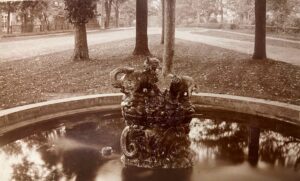
The Cat and Dog fountain, installed in 1862 thanks to summer resident John H. Gourlie of New York City, is now being restored thanks to a Community Preservation effort. Jokingly said to illustrate the relationship between year-round and part time residents,
Field Family Collection, acc# 2014.099
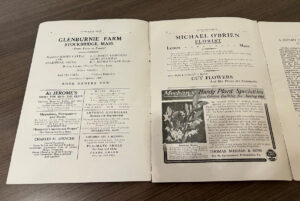 In 1914, Walter Pritchard Eaton began publishing a monthly magazine called simply “Stockbridge.” The articles written in the “Stockbridge” magazines are quite illuminating and entertaining to read today as I am sure they were when first published.
In 1914, Walter Pritchard Eaton began publishing a monthly magazine called simply “Stockbridge.” The articles written in the “Stockbridge” magazines are quite illuminating and entertaining to read today as I am sure they were when first published.
Stockbridge Imprints Collection 2000.118
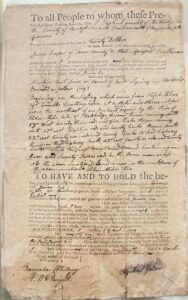
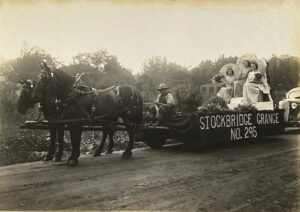 In 1939, for the bicentennial celebration of the town of Stockbridge, a series of photographs were taken of the floats that made up the celebratory parade.
In 1939, for the bicentennial celebration of the town of Stockbridge, a series of photographs were taken of the floats that made up the celebratory parade.
This picture of the Stockbridge Grange float was one that we did not have, but thanks to the Albert J. Thomas Library and Museum, we now have a digital copy to add to our collection.
Albert J. Thomas Library and Museum of the Massachusetts State Grange, Rutland, MA/Stockbridge Library Museum & Archives Photography Collection
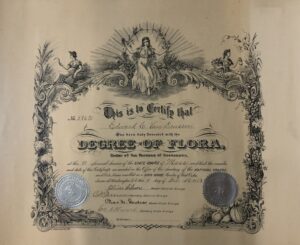 In 1910 a group of like minded citizens, concerned and interested in promoting agriculture, got together to organize the Stockbridge Grange.
In 1910 a group of like minded citizens, concerned and interested in promoting agriculture, got together to organize the Stockbridge Grange.
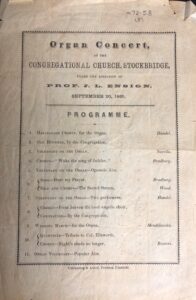 In 1865 the First Congregational Church in Stockbridge engaged local carpenter George Knowles to install an arch and rework the back of the church to accommodate the new William Johnson organ.
In 1865 the First Congregational Church in Stockbridge engaged local carpenter George Knowles to install an arch and rework the back of the church to accommodate the new William Johnson organ.
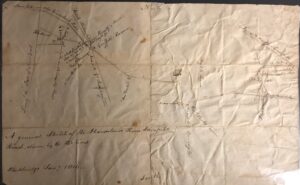 Maps tell an interesting story of where we have been and where we are today. This 1814 survey of the Housatonic River Turnpike shows the main thoroughfare through Stockbridge.
Maps tell an interesting story of where we have been and where we are today. This 1814 survey of the Housatonic River Turnpike shows the main thoroughfare through Stockbridge.
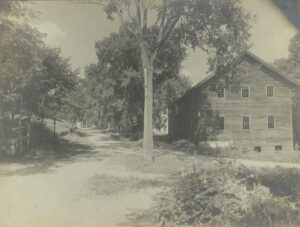 It is always interesting to look at old photographs and see the world from the perspective of another century. This photograph, taken in the 1890’s, shows what today is Route 183 where it meets with Train Hill Road looking north. The building on the right is the old wood pulp mill built in 1866. If you look close enough you can see clear up to the old brick store.
It is always interesting to look at old photographs and see the world from the perspective of another century. This photograph, taken in the 1890’s, shows what today is Route 183 where it meets with Train Hill Road looking north. The building on the right is the old wood pulp mill built in 1866. If you look close enough you can see clear up to the old brick store.
Curtisville Collection 1973.003
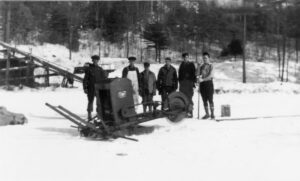
The Schneyer family on Mohawk Lake, also known as Hagar Pond, has a storied history when it comes to ice harvesting. Beginning in the late 19th century and continuing into the 1950’s the Schneyer Ice Company supplied many local families and businesses with ice for refrigeration and cooling.
These two images are from the 1940’s and show how the art of ice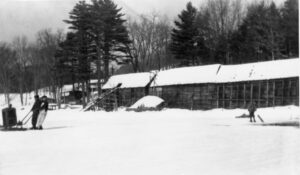 cutting had changed with new technologies. Here you see the large circular saw used to cut the ice rather than the larger manual tools, and the ice house where everything was stored until needed in the summer.
cutting had changed with new technologies. Here you see the large circular saw used to cut the ice rather than the larger manual tools, and the ice house where everything was stored until needed in the summer.
Stockbridge Library Museum & Archives Digital Photography Collection 2017.038
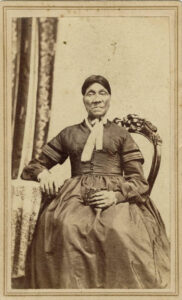
Margaret “Peggy” Timbrook Hull was the second wife of Agrippa Hull, married in Stockbridge in 1813. Peggy and Agrippa were well known for their abilities to cater a good party and were noted for their gingerbread and root beer. This carte de visite of Peggy was taken in Lee, MA in the late 1860’s and shows a strong yet aged matron. Peggy died in May of 1870 at nearly 90 years of age.
Interested in learning more about Agrippa and Peggy Hull? Stop by the Proctor Gallery and check out our current exhibit.
Agrippa Hull Collection 73.202
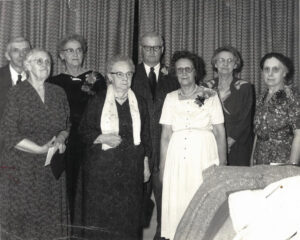 In October 1960 the membership of Stockbridge Grange gathered for the purpose of celebrating their 50th anniversary. This photograph was taken of the 8 surviving charter members. They were (from left to right): Herbert Cooper, Elsie Noble, Ruth Williams, Mary Rathbun, William Cummings, Margaret Truran, Ethel MacClintock, and Ruth Krebs.
In October 1960 the membership of Stockbridge Grange gathered for the purpose of celebrating their 50th anniversary. This photograph was taken of the 8 surviving charter members. They were (from left to right): Herbert Cooper, Elsie Noble, Ruth Williams, Mary Rathbun, William Cummings, Margaret Truran, Ethel MacClintock, and Ruth Krebs.
Ruth Krebs was the last surviving charter member of Stockbridge Grange when she died in 1991 at the age of 96.
Stockbridge Grange #295 Records 2016.013
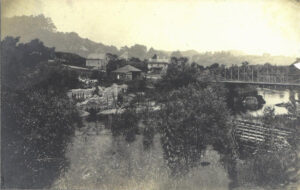
The village of Glendale in the 1890’s was the busy industrial center in Stockbridge. However, the ever present danger of fires brought an end to both the woolen mill and the paper mill in the village.
This photograph from the mid-1890’s, taken from the railroad tracks looking north, shows the charred remains of the Glendale Woolen Mill, the foreman’s house, the “Beehive” where workers lived, and the old iron truss bridge.
Stockbridge Library Museum & Archives Photography Collection 2016.124.01
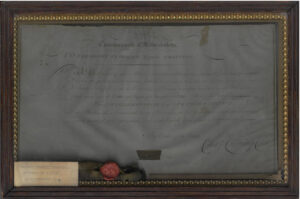 Theodore Sedgwick (1746-1813) is most well known, in the Berkshires, for his handling of the Brom & Bett v. Ashley case in 1781, which secured the freedom of two slaves of Col. John Ashley; that of Brom and Mum Bett, also known as Elizabeth Freeman.
Theodore Sedgwick (1746-1813) is most well known, in the Berkshires, for his handling of the Brom & Bett v. Ashley case in 1781, which secured the freedom of two slaves of Col. John Ashley; that of Brom and Mum Bett, also known as Elizabeth Freeman.
Following his time as a lawyer, Sedgwick was elected as a Representative to Congress from Massachusetts in 1789 until he became a Senator in 1796. Then in 1799 he returned to the House of Representatives and was elected its fourth Speaker of the House, a position he held until 1801. The following year, 1802 he was appointed to the Massachusetts Supreme Court, a position which he held until his death some 11 years later.
This framed document is dated 1783 and admits Theodore Sedgwick, Esq. as a barrister at law.
Sedgwick Family Collection 1971.185
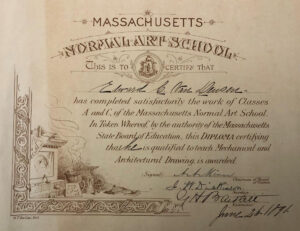 Edward C. Van Deusen (1869-1937) was the third generation of Van Deusens in Stockbridge to run the family hardware and plumbing business on Elm Street. However, before he took on the family business, Edward attended Williams High, continued on to Wilbraham Academy, and then graduated from the Massachusetts Normal Art School in Boston, as is evidenced by his diploma pictured here.
Edward C. Van Deusen (1869-1937) was the third generation of Van Deusens in Stockbridge to run the family hardware and plumbing business on Elm Street. However, before he took on the family business, Edward attended Williams High, continued on to Wilbraham Academy, and then graduated from the Massachusetts Normal Art School in Boston, as is evidenced by his diploma pictured here.
Van Deusen Family Papers 2015.072
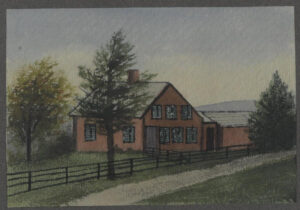 If you have ever attended Tanglewood and parked at the Lion’s Gate you will have undoubtedly seen the “Hawthorne Cottage,” Interestingly, the gentleman who gives his name to the building and a road and street to boot, Nathaniel Hawthorne, was only an occupant of the building for just over a year and a half from March 1850 to November 1851.
If you have ever attended Tanglewood and parked at the Lion’s Gate you will have undoubtedly seen the “Hawthorne Cottage,” Interestingly, the gentleman who gives his name to the building and a road and street to boot, Nathaniel Hawthorne, was only an occupant of the building for just over a year and a half from March 1850 to November 1851.
This watercolor of the Hawthorne House is dated 1865, done over a decade following his family’s tenure here in Stockbridge. It is humorous to note that Hawthorne could not wait to leave the Berkshires. Despite everything that drew and still draws people here, he could not stomach going through another bleak, cold winter here.
Stockbridge Library Museum & Archives Art Collection 1998.047
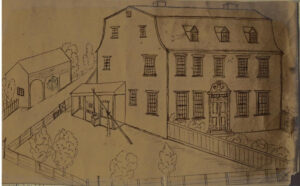 Every once in a while something different is uncovered in the Museum & Archives. This drawing is an example of that. It is a 1907 sketch of what the house of Ephraim Williams on Prospect Hill might have looked like. Williams was the father-in-law to Reverend John Sergeant.
Every once in a while something different is uncovered in the Museum & Archives. This drawing is an example of that. It is a 1907 sketch of what the house of Ephraim Williams on Prospect Hill might have looked like. Williams was the father-in-law to Reverend John Sergeant.
With the sketch comes an interesting description: Built 1750 – the clapboards were 3 1/2′ long and 5″ wide lasting 100 years. It was subsequently occupied by Rev. Stephen West, who married Elizabeth, sister of Abigail Sergeant Dwight. The old “fort” well is still under the present house “Windermere” owned by Dr. Henry Field. The Williams house, an almost impregnable fortress, was planked by black oak and surrounded by a moat.
Stockbridge Library Photography Collection
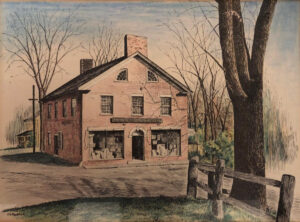 Frank S. Packlick (1921-2014) worked as a chef at the Austen Riggs Center. However, that is not what Mr. Packlick is best remembered for. Following his service in the Navy as a cook during World War II, Mr. Packlick studied at the New England Art School. This is where he honed his drawing skills.
Frank S. Packlick (1921-2014) worked as a chef at the Austen Riggs Center. However, that is not what Mr. Packlick is best remembered for. Following his service in the Navy as a cook during World War II, Mr. Packlick studied at the New England Art School. This is where he honed his drawing skills.
This print of the Glendale Store is just one of numerous historical buildings, people, animals, and nature scenes drawn by Frank Packlick. The Museum & Archives is proud to have other examples of his work, such as prints of Naumkeag and the Children’s Chimes, and the Red Lion Inn.
Stockbridge Library Museum & Archives Art Collection – 1967.10
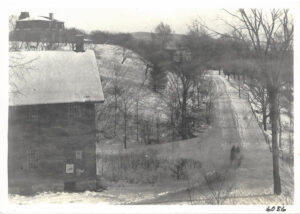 Let us take a trip back to the turn of the last century during the winter months. This week, we have an image of Curtisville looking south down what is today Route 183. The building in the foreground is the original wood pulp grinding mill and at the top you can see Citizen’s Hall.
Let us take a trip back to the turn of the last century during the winter months. This week, we have an image of Curtisville looking south down what is today Route 183. The building in the foreground is the original wood pulp grinding mill and at the top you can see Citizen’s Hall.
David Milton Jones Photography Collection 2000.26.324
This undated photograph says it all! A group of young students waiting with great anticipation for the holiday break to begin while enjoying some holiday cheer!
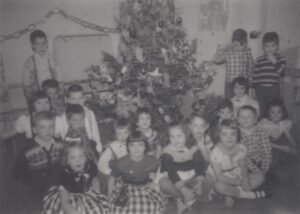
Happy Holidays from the Museum & Archives.
Stockbridge Library Photography Collection 1994.814
This past week Stockbridge has been a picture-perfect winter 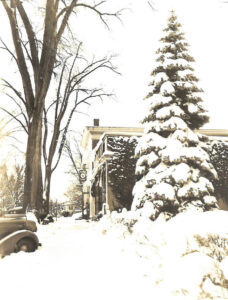 wonderland. This photograph from 1943 shows a similar scene on Elm Street. The caption on the reverse reads:
wonderland. This photograph from 1943 shows a similar scene on Elm Street. The caption on the reverse reads:
“X-mas tree in front of J(oseph) Franz’s house on Elm St.”
David Milton Jones Photography Collection 2000.028.053
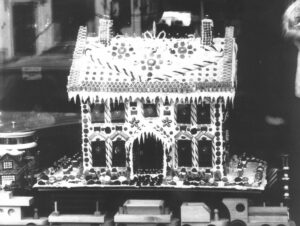 Nothing screams “Holidays!” more than a gingerbread house. This photograph from the late 1970’s shows one of Philip Creelman’s creations, which he used to display in the front window of Williams and Sons Country Store, which he and his wife Vivien owned at the time.
Nothing screams “Holidays!” more than a gingerbread house. This photograph from the late 1970’s shows one of Philip Creelman’s creations, which he used to display in the front window of Williams and Sons Country Store, which he and his wife Vivien owned at the time.
Williams and Sons Collection 1975.006
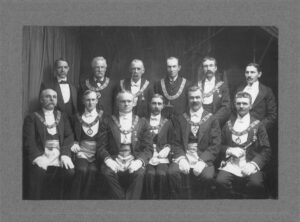 In 1870 a group of gentlemen from Stockbridge petitioned the Grand Lodge of Masons in Massachusetts to organize a Masonic Lodge in the town of Stockbridge.
In 1870 a group of gentlemen from Stockbridge petitioned the Grand Lodge of Masons in Massachusetts to organize a Masonic Lodge in the town of Stockbridge.
This would not be the first Lodge in town. The first Lodge in Berkshire County, Berkshire Lodge #5, was organized by General John Paterson and others in 1777. A charter was granted in 1871 and the Lodge recently celebrated its 150th anniversary.
This photograph from 1905 shows the officers of Occidental Lodge as well as the suite for Lodge member Allen T. Treadway who was elected that year to be the District Deputy Grand Master.
Stockbridge Library Museum & Archives Photography Collection 1994.399c
The Thanksgiving of 1965 would change Stockbridge in ways that it 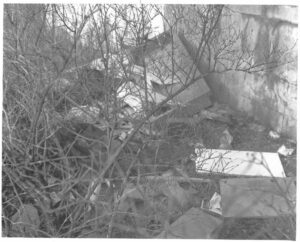 could not imagine. Two young men were on a mission to discard some garbage following a great Thanksgiving meal.
could not imagine. Two young men were on a mission to discard some garbage following a great Thanksgiving meal.
These photographs from our collection show “the scene of the crime.” But things went south when Officer Obie telephoned looking for Arlo.
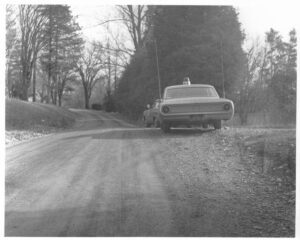 The whole story made for some interesting lyrics by 1967, and by 1969 Stockbridge was in the movies! Now it is a Berkshire tradition to listen to Alice’s Restaurant on Thanksgiving.
The whole story made for some interesting lyrics by 1967, and by 1969 Stockbridge was in the movies! Now it is a Berkshire tradition to listen to Alice’s Restaurant on Thanksgiving.
Stockbridge Library Museum & Archives Photography Collection 1989.200.7
Miss Mabel Choate, daughter of the Hon. Joseph Hodges and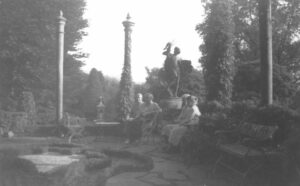 Caroline Sterling Choate, loved her gardens at Naumkeag. This photograph, taken in the summer of 1953, shows Miss Choate enjoying a relaxing talk with friends Mr. H.J. Haire, Mrs. Grace Wilcox, and Miss Matilda Brownell.
Caroline Sterling Choate, loved her gardens at Naumkeag. This photograph, taken in the summer of 1953, shows Miss Choate enjoying a relaxing talk with friends Mr. H.J. Haire, Mrs. Grace Wilcox, and Miss Matilda Brownell.
The new exhibit at the Proctor Gallery highlights Mabel and Caroline Choate and Naumkeag. Please stop by and have a look.
Stockbridge Library Museum & Archives Photography Collection 1994.866
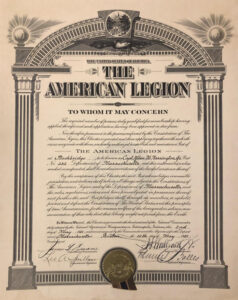 This past Friday marked the annual observance of Veterans Day, originally known as Armistice Day. This day was meant to mark the ceasefire agreement that brought a conclusion to World War I.
This past Friday marked the annual observance of Veterans Day, originally known as Armistice Day. This day was meant to mark the ceasefire agreement that brought a conclusion to World War I.
In October of 1919, nearly a year after World War I ended, the Capt. Allen W. Harrington, Jr. Post # 232 of the American Legion received its original charter. Pictured here, 15 charter members are listed on the document.
Subsequent charters would be issued to the Post through the 1980s.
American Legion Collection 2016.047
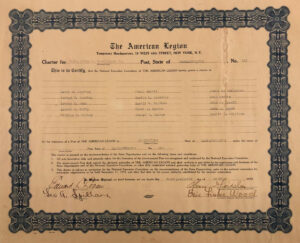
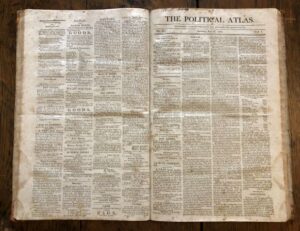
Not long ago, the Berkshire Eagle re-published an article from 1970 under their “Story in History” headline that talked about a bound volume of newspapers printed in Stockbridge called The Political Atlas. Our assistant curator, Joshua Hall, tracked down the original volume, which is shown above.
If you would like to read the article you can find it here.
Stockbridge Imprints Collection 1970.010
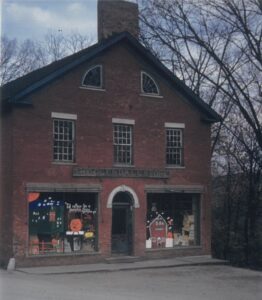
Halloween is a time for spooky things. These photos depict the window paintings done by area children back in the 1950’s. One picture shows the old Glendale Store with its large display windows. The other photograph is of the Meat Market on Main Street.
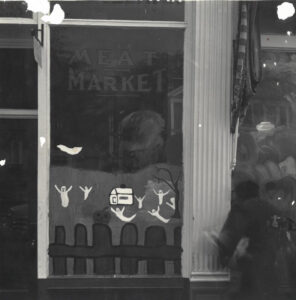
Stockbridge Library Museum & Archives Photography Collection 1994.538, 1994.604
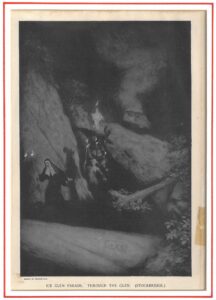 The torchlit parade through Ice Glen has been an autumnal Stockbridge tradition for as far back as many a collective memory can serve. This illustration from 1895 in Century Magazine even shows the participants in costume. However, when this illustration was created the march through Ice Glen did not take place in the autumn months, but in fact during the summer months.
The torchlit parade through Ice Glen has been an autumnal Stockbridge tradition for as far back as many a collective memory can serve. This illustration from 1895 in Century Magazine even shows the participants in costume. However, when this illustration was created the march through Ice Glen did not take place in the autumn months, but in fact during the summer months.
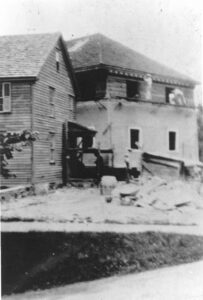 In August of 1926, it was announced that Mabel Choate had purchased the former home of missionary Reverend John Sergeant for the purpose of turning it into a public museum. The museum was dedicated to the memory of her father, New York City lawyer and former Ambassador to the Court of St. James, Joseph H. Choate.
In August of 1926, it was announced that Mabel Choate had purchased the former home of missionary Reverend John Sergeant for the purpose of turning it into a public museum. The museum was dedicated to the memory of her father, New York City lawyer and former Ambassador to the Court of St. James, Joseph H. Choate.
You may know this museum as Stockbridge’s Mission House located at 19 Main Street.
The Newspaper announcement stated that H.D. Sleeper of Boston would oversee the restoration work and that the building would be moved to Main Street where the Stockbridge Casino was then located. The new location of the Mission House meant that the Stockbridge Casino would also need to be moved. The Casino was moved to the east end of Main Street.
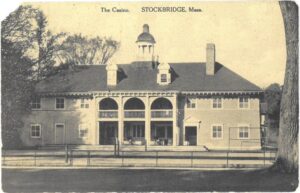
This week’s pictures show the Stockbridge Casino in its location at the corner of Main Street and Casino Street, as well as the only photograph of the Mission House and the Stockbridge Casino in the same site, with the Casino in the process of being moved.
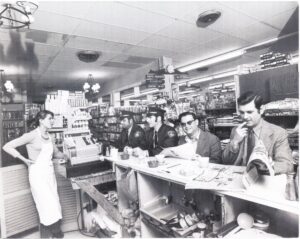 Today we are taking a trip back to the food counter at Nejaime’s Market. Pictured are a few prominent faces from Stockbridge including Louis Peyron, Rick Wilcox, and John Cronson. Although some of the names on the buildings of Main Street have changed, luckily the hospitality inside has not.
Today we are taking a trip back to the food counter at Nejaime’s Market. Pictured are a few prominent faces from Stockbridge including Louis Peyron, Rick Wilcox, and John Cronson. Although some of the names on the buildings of Main Street have changed, luckily the hospitality inside has not.
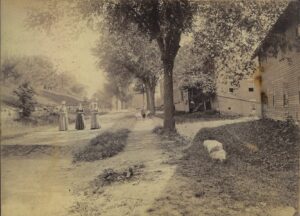 The next time you are driving up Route 183 through Interlaken keep this photograph in mind. This picture was taken looking north. At the far end of the picture you see the brick store building. To the right are some mill houses and the original wood pulp mill building as well.
The next time you are driving up Route 183 through Interlaken keep this photograph in mind. This picture was taken looking north. At the far end of the picture you see the brick store building. To the right are some mill houses and the original wood pulp mill building as well.
Maps are a vital source of information. They help us get where we want to go and can also lead us back in time. Older maps help us to see how roads and properties have evolved over the years. 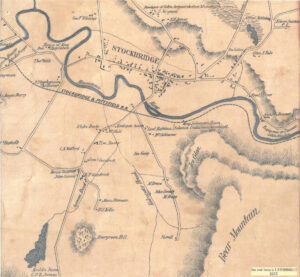
Sometimes maps include family names from days gone by. This 1855 map of Stockbridge shows the name of one Dr. J(oab) Kellis near Evergreen Hill.
Joab Kellis, M.D., Berkshire county’s first African American physician, was born and raised in Stockbridge and studied medicine under Dr. Erastus Sergeant. He served the communities of both Lee and Stockbridge and was well regarded for his medical, political, historical, and theological knowledge. When he died in 1866 at the age of 63 in abject poverty, he was so well regarded by the townspeople that the town of Stockbridge saw fit to pay for his funeral and eventually his tombstone.
1855 Map of Stockbridge & West Stockbridge 2011.050.10
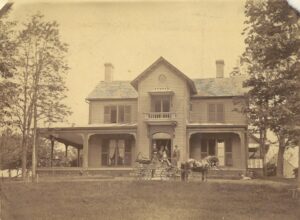 Built on the site of Ephriam Williams’ late 1730’s homestead stands the former residence of Rev. Henry Martyn Field. He attended Williams College and graduated in 1838 at the age of 16. A minister and a writer, Henry Field was best known for his books related to his world travels and for being the publisher and editor of The Evangelist for over four decades.
Built on the site of Ephriam Williams’ late 1730’s homestead stands the former residence of Rev. Henry Martyn Field. He attended Williams College and graduated in 1838 at the age of 16. A minister and a writer, Henry Field was best known for his books related to his world travels and for being the publisher and editor of The Evangelist for over four decades.
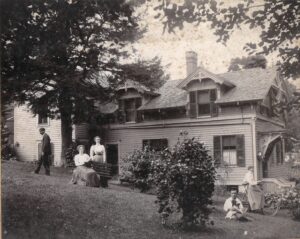 Learning more about the community around us is the best way to understand the community we live in. This photograph, from about 1890, is of the James F. Whitehead family who lived in the Glendale section of Stockbridge. Whitehead was a painter by trade and shared this house with his wife Lillian, son James C, sister Eva, and mother Laura.
Learning more about the community around us is the best way to understand the community we live in. This photograph, from about 1890, is of the James F. Whitehead family who lived in the Glendale section of Stockbridge. Whitehead was a painter by trade and shared this house with his wife Lillian, son James C, sister Eva, and mother Laura.
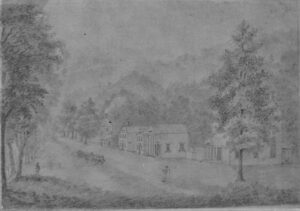 As the summer starts to slow down, children begin to return to school, and the cool of autumn begins to slowly creep in, we see a change in the Main Street of Stockbridge.
As the summer starts to slow down, children begin to return to school, and the cool of autumn begins to slowly creep in, we see a change in the Main Street of Stockbridge.
Stockbridge Library Museum & Archives Photography Collection 1994.345
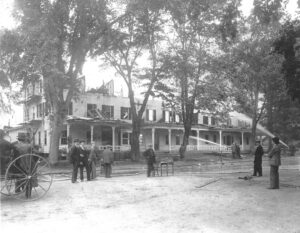 On the morning of August 31, 1896 the Stockbridge House, also known as Plumb Hotel, and today called the Red Lion Inn, burned to the ground. This icon of the Main Street of Stockbridge ceased to exist. Luckily this was not the end of the story. Like the proverbial phoenix rising from the ashes, so too did the Red Lion Inn. Within a year’s time the site was cleared of rubble and a new edifice stood in its place.
On the morning of August 31, 1896 the Stockbridge House, also known as Plumb Hotel, and today called the Red Lion Inn, burned to the ground. This icon of the Main Street of Stockbridge ceased to exist. Luckily this was not the end of the story. Like the proverbial phoenix rising from the ashes, so too did the Red Lion Inn. Within a year’s time the site was cleared of rubble and a new edifice stood in its place.
Stockbridge Library Museum & Archives Photography Collection 1995.106.8
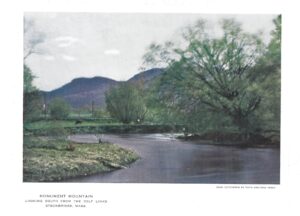 For the years 1914 and 1915 author Walter Prichard Eaton, with the help of Jennie Seymour, R.R. Bowker, and Bernhard Hoffmann, published a monthly magazine called Stockbridge. Usually condensed into a dozen or so pages, the Stockbridge magazine was an excellent source of the town’s goings-on, a source of old photographs, and a place to advertise your business. Each edition holds a plethora of tidbits of information about what life was like in Stockbridge over that two year period.
For the years 1914 and 1915 author Walter Prichard Eaton, with the help of Jennie Seymour, R.R. Bowker, and Bernhard Hoffmann, published a monthly magazine called Stockbridge. Usually condensed into a dozen or so pages, the Stockbridge magazine was an excellent source of the town’s goings-on, a source of old photographs, and a place to advertise your business. Each edition holds a plethora of tidbits of information about what life was like in Stockbridge over that two year period.
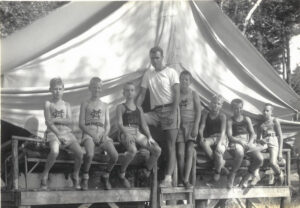 In 1929 Joseph Kruger came to Berkshire County to start a camp for young boys, aged 6-16, that was based in educational practices. He leased Yokum Camp from Miss Mary E. Richardson, who had previously run a girls camp, and set out with Barney Koplin to develop his own camp. In 1934 a corporation known as Camp Mac-Kee-Nac was formed, land along the Stockbridge Bowl was purchased, and Mr. Kruger moved his camp from Richmond to Stockbridge creating Camp Mah-Kee-Nac.
In 1929 Joseph Kruger came to Berkshire County to start a camp for young boys, aged 6-16, that was based in educational practices. He leased Yokum Camp from Miss Mary E. Richardson, who had previously run a girls camp, and set out with Barney Koplin to develop his own camp. In 1934 a corporation known as Camp Mac-Kee-Nac was formed, land along the Stockbridge Bowl was purchased, and Mr. Kruger moved his camp from Richmond to Stockbridge creating Camp Mah-Kee-Nac.
Stockbridge Library Photography Collection 2014.011
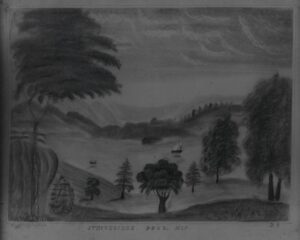 In 1841 Edward Hitchcock published Final Report on the Geology of Massachusetts. His book included illustrations drawn by a variety of local artists and included this image of “Stockbridge Pond,” which is our Stockbridge Bowl.
In 1841 Edward Hitchcock published Final Report on the Geology of Massachusetts. His book included illustrations drawn by a variety of local artists and included this image of “Stockbridge Pond,” which is our Stockbridge Bowl.
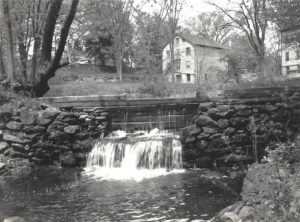 There are many hidden pieces of history that one can find throughout Stockbridge. This photograph from 1938 shows an old mill dam that was situated at the stream behind St. Helen’s Home. You can see the old store and post office in the background.
There are many hidden pieces of history that one can find throughout Stockbridge. This photograph from 1938 shows an old mill dam that was situated at the stream behind St. Helen’s Home. You can see the old store and post office in the background.
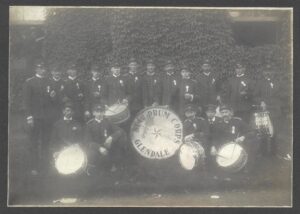 The Star Drum Corps, composed primarily of gentlemen from the Glendale section of Stockbridge, was created around 1903 and was in existence for over a decade. Drum corps were very popular in the later part of the 19th century and into the early decades of the 20th century, and Stockbridge had two!
The Star Drum Corps, composed primarily of gentlemen from the Glendale section of Stockbridge, was created around 1903 and was in existence for over a decade. Drum corps were very popular in the later part of the 19th century and into the early decades of the 20th century, and Stockbridge had two!
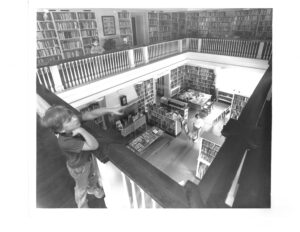 Libraries are a magical place, and this photograph from the 1980’s reflects the mystery, enjoyment, learning, and diversity of our little library.
Libraries are a magical place, and this photograph from the 1980’s reflects the mystery, enjoyment, learning, and diversity of our little library.
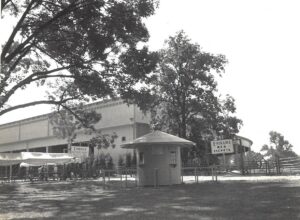 Two weeks ago photographs from 1934’s Berkshire Symphonic Festival were shown giving you a sense of how Tanglewood started. This week we have a photograph from the opening of the 1938 season.
Two weeks ago photographs from 1934’s Berkshire Symphonic Festival were shown giving you a sense of how Tanglewood started. This week we have a photograph from the opening of the 1938 season.
This shows the newly completed Shed and the ticket booth known as the “Roundhouse.”
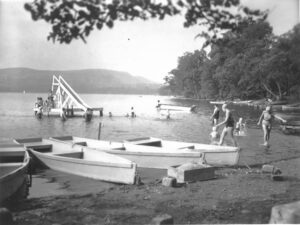 What better place to cool down, on a hot summer’s day, than the Stockbridge Town Beach?
What better place to cool down, on a hot summer’s day, than the Stockbridge Town Beach?
David Milton Jones Photography Collection 2000.026.
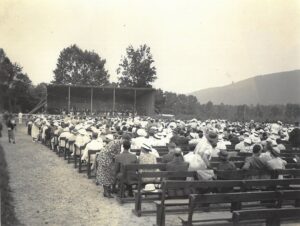 In 1934 a small group of summer residents conceived the idea of having a summer venue in the Berkshires to hear classical music. That idea coalesced into the Berkshire Symphonic Festival which was held on the giant horse track at Bonnie Brier, the estate of Dan Hanna in Interlaken. This from 1934 shows the earliest phase of what would become Stockbridge’s beloved Tanglewood.
In 1934 a small group of summer residents conceived the idea of having a summer venue in the Berkshires to hear classical music. That idea coalesced into the Berkshire Symphonic Festival which was held on the giant horse track at Bonnie Brier, the estate of Dan Hanna in Interlaken. This from 1934 shows the earliest phase of what would become Stockbridge’s beloved Tanglewood.
David Milton Jones Photography Collection 2000.026
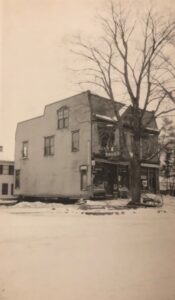 In 1916 the layout of Main Street shifted ever so slightly, in the vicinity of St. Paul’s Episcopal Church. The Seymour block, later referred to as the Benjamin Block, made a shift east while the house that is today the St. Paul parsonage shifted west.
In 1916 the layout of Main Street shifted ever so slightly, in the vicinity of St. Paul’s Episcopal Church. The Seymour block, later referred to as the Benjamin Block, made a shift east while the house that is today the St. Paul parsonage shifted west.
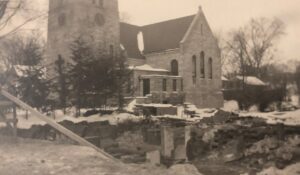
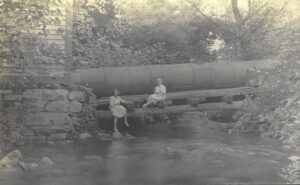 As you meander along Route 183 north through Interlaken towards Tanglewood and Lenox, you may notice on the right hand side of the road, near the keystone arched bridge, an area where there was once a pipe. The large pipe pictured in this photograph from the turn of the last century, was one that fed water from upstream at the Stockbridge Bowl into the old Baker mill. Otis and Benjamin Baker tried their hands at textiles, wood pulp and as a foundry, but the mill was abandoned in 1893 and eventually torn down in 1927. Stockbridge Library Museum & Archives Photography Collection 1994.823.9
As you meander along Route 183 north through Interlaken towards Tanglewood and Lenox, you may notice on the right hand side of the road, near the keystone arched bridge, an area where there was once a pipe. The large pipe pictured in this photograph from the turn of the last century, was one that fed water from upstream at the Stockbridge Bowl into the old Baker mill. Otis and Benjamin Baker tried their hands at textiles, wood pulp and as a foundry, but the mill was abandoned in 1893 and eventually torn down in 1927. Stockbridge Library Museum & Archives Photography Collection 1994.823.9
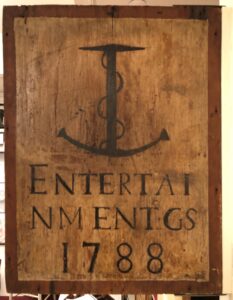
Although the Red Lion Inn or Michael’s might be the place to go today if you are looking for libation and entertainment, in 1788 you would want to go to Gideon Smith’s inn and tavern. This sign advertising Smith’s tavern is all that remains today.
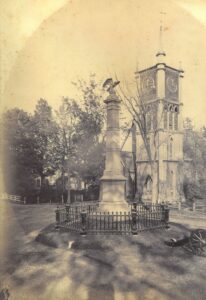 This image of the town’s Civil War monument was taken in 1866 just following its dedication. It was one of the first Civil War monuments dedicated in Berkshire County. Notice a very different looking St. Paul’s Episcopal Church.
This image of the town’s Civil War monument was taken in 1866 just following its dedication. It was one of the first Civil War monuments dedicated in Berkshire County. Notice a very different looking St. Paul’s Episcopal Church.
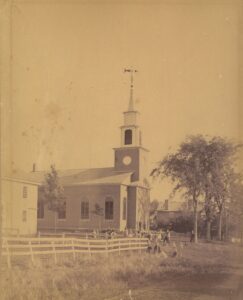
As the weather warms, students are again able to enjoy recess out of doors. These young pupils at the Curtisville school look to be enjoying themselves on this nice spring day.
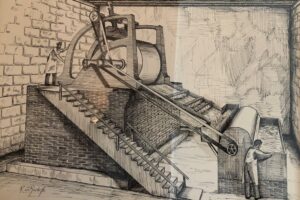 In 1867, in the Curtisville area of Stockbridge, the first viable wood pulp was made in the United States using machines purchased from Germany. The Keller-Voelter grinding apparatus is pictured in the rendition of what the original may have looked like.
In 1867, in the Curtisville area of Stockbridge, the first viable wood pulp was made in the United States using machines purchased from Germany. The Keller-Voelter grinding apparatus is pictured in the rendition of what the original may have looked like.
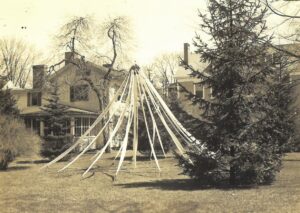
May has arrived! What better event to recall from by-gone days than the Annual May Day celebration hosted by St. Paul’s Episcopal Church, circa early 1940s.
David Milton Jones Photography Collection 2000.026
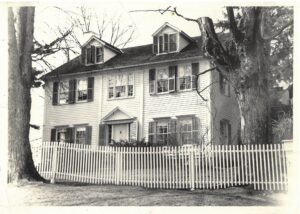
This 18th century home, built on Prospect Hill, was the residence of Samuel Jerome. He was a Revolutionary War veteran from Connecticut who moved his family to Stockbridge for new ventures. Over time, several of his descendants moved to New York City and even London. One of Samuel’s great-grandsons was none other than Sir Winston Churchill, his mother was Jennie Jerome who married a British aristocrat and was known as Lady Randolph Churchill. Stockbridge Library Photography Collection #1994.748
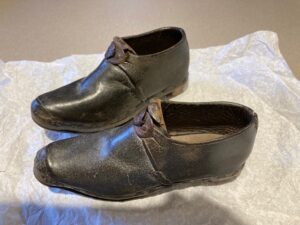 Pair of child’s clogs worn by mill workers, primarily in Lancaster, England, circa 1800’s. Adults wore laced and clasped clogs, with fastening clasps of engraved brass. These clogs were donated by Miss Emily Smith. These shoes be featured in our previous exhibit in the Procter Gallery! #53.016
Pair of child’s clogs worn by mill workers, primarily in Lancaster, England, circa 1800’s. Adults wore laced and clasped clogs, with fastening clasps of engraved brass. These clogs were donated by Miss Emily Smith. These shoes be featured in our previous exhibit in the Procter Gallery! #53.016

We’re more social than ever!
Join us on Instagram and Facebook for news, fun photos, and more!
Be in the know about events and news!
Get regular updates on library news and events delivered to your inbox!
Join the Mailing List